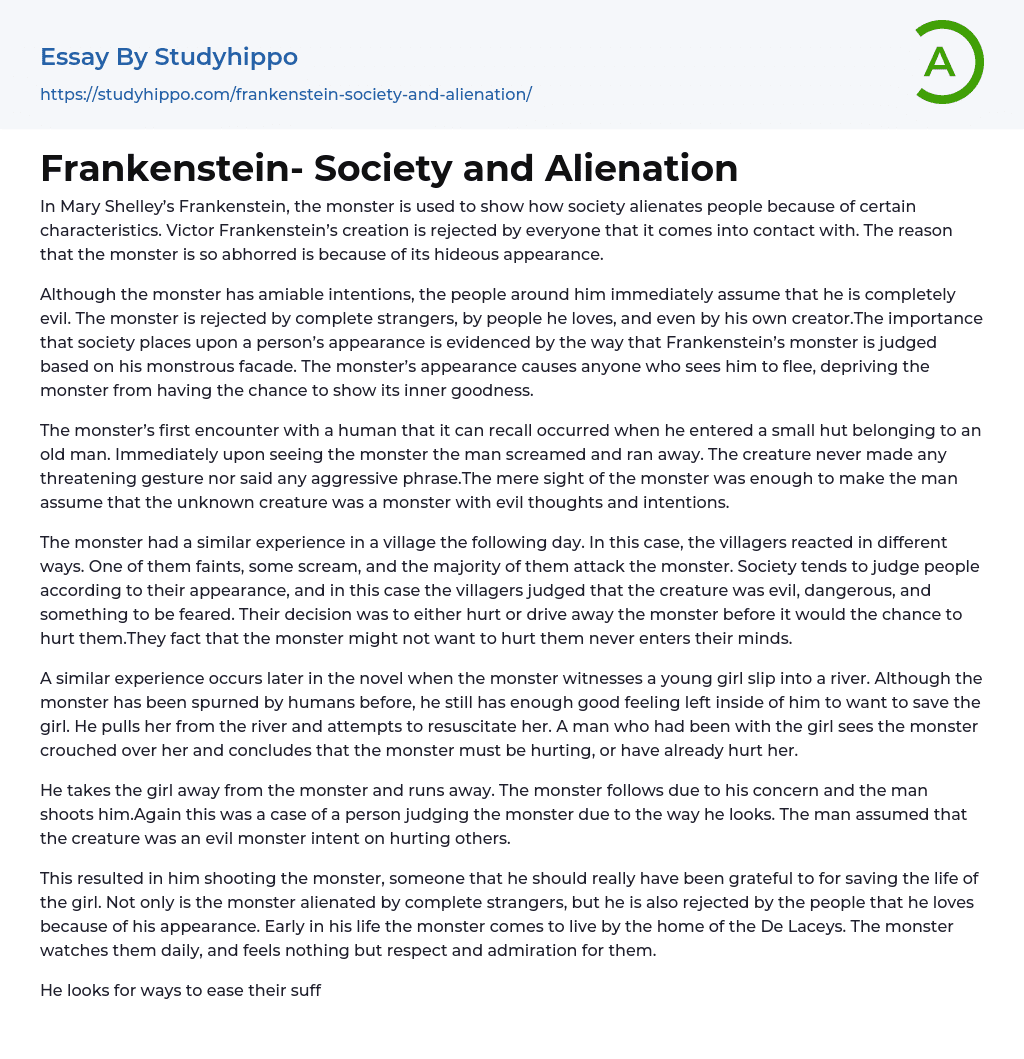The rejection of Victor Frankenstein's creation in Mary Shelley's Frankenstein illustrates how society can alienate individuals based on certain traits, such as appearance. The monstrous appearance of the creature is the primary reason for its widespread revulsion and rejection.
The monster, despite his good intentions, is rapidly branded as evil by those in his surroundings - strangers, loved ones and even his maker. The societal focus on physical appearance is accentuated through the condemnation of the monster's monstrous facade. His alarming exterior prompts people to run away, thus preventing them from discovering the goodness inside him.
The monster's first encounter with a human that it can recall occurred in a small shack belonging to an elderly man. Upon seeing the monster, the man screamed and ran away without any provocation from the monster. The mons
...ter did not engage in any threatening behavior or language, yet its mere presence was enough for the man to perceive it as a dangerous and malevolent entity.
The monster experienced a comparable scenario in another village on the following day but encountered diverse reactions from the villagers. Although some screamed and one person fainted, most opted to assault the creature. The society's perception of the monster's appearance made it facile for them to characterize it as malevolent, hazardous, and a risk to their well-being. As a result, they instinctually chose to cause harm or banish the monster before it could inflict any damage upon them. They did not even consider that perhaps the monster had no intention of harming them.
As the novel progresses, the monster observes a comparable incident in which a young girl falls into a river. Despite his prior rejection by
mankind, he retains some empathy and endeavors to rescue her. After pulling her from the water, he attempts to revive her. Unfortunately, an onlooker assumes that the monster is harming or has harmed the girl when they observe him crouched beside her.
Following the rescue of the girl from a monster, the man flees while being pursued. Due to fear and assuming it is evil, he ultimately shoots down the creature. This serves as an unfortunate instance of solely judging someone based on their physical appearance.
Despite saving a girl's life, the monster is alienated and rejected by both strangers and loved ones due to his appearance. Living near the De Laceys, the monster respects and admires them while being shunned by others. As a result, he shoots a creature that he should have been grateful to for saving a life.
He seeks to alleviate their pain, ceasing when he realizes their distress when consuming their food. Watching Felix gather wood, he decides to do the same at night to aid the cottagers and ease his friend's workload. For months, he prepares to speak with the family, banking on a successful outcome. He hopes his eloquence, learned from observing them, will overcome their revulsion towards his appearance. His initial effort is directed at the elderly gentleman.
The monster meets someone who listens without judgement. This person is unique because they are blind. However, when the rest of the De Laceys see the monster, they react the same way as everyone else. Felix sees the monster with his father and assumes that he is dangerous, leading him to attack.
The monster causes the family to flee their home, resulting in significant
financial loss. Despite having warm feelings towards the family and having no ill intentions, the creature is hated by them. This contributes to its transformation into the assumed monster. Victor Frankenstein is also repulsed by the creature's appearance, despite being its creator and having control over its appearance. It appears that Frankenstein despises the monster because it is unnatural, unlike anything society has ever seen.
Victor judges the monster solely based on its looks, assuming that it is responsible for great evils and he doesn't take the time to understand the creature's true nature. He abandons his responsibilities as a creator and rejects his own creation due to disgust. The hideous appearance of the monster also causes society to continuously alienate it.
There is a common belief that goodness is linked to beauty, while evil is connected to ugliness. In the story, society's unkind judgments corrupt the initially virtuous creature, transforming him into the monstrous being they assumed he was.
- Allegory essays
- Alliteration essays
- Comedy essays
- Comic book essays
- Drama essays
- Dystopia essays
- Fairy Tale essays
- Fantasy essays
- Fiction essays
- Ghost essays
- Gothic Fiction essays
- Gothic Literature essays
- Irony essays
- Legend essays
- Memoir essays
- Novel essays
- Poetry essays
- Satire essays
- Science Fiction essays
- Short Story essays
- The western essays
- Tragedy essays
- Witchcraft essays
- 1984 essays
- A Farewell to Arms essays
- A Good Man Is Hard to Find essays
- A Hanging essays
- A Lesson Before Dying essays
- A Long Way Gone essays
- A Rose For Emily essays
- A Separate Peace essays
- A Tale Of Two Cities essays
- A Very Old Man With Enormous Wings essays
- Adventures Of Huckleberry Finn essays
- Alice in Wonderland essays
- All Quiet on The Western Front essays
- Allegory of the Cave essays
- An occurrence at owl creek bridge essays
- Animal Farm essays
- Anthem essays
- Antigone essays
- Arthur Conan Doyle essays
- As I Lay Dying essays
- Atticus Finch essays
- Barn Burning essays
- Battle Royal essays
- Beauty and The Beast essays
- Beloved essays
- Boo Radley essays
- Brave New World essays




